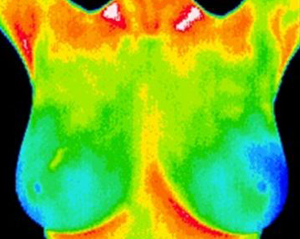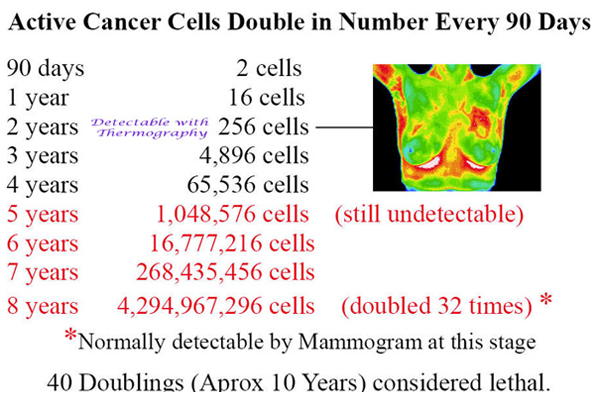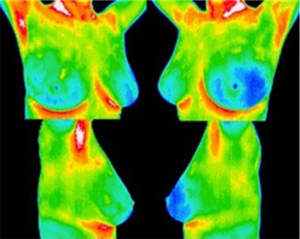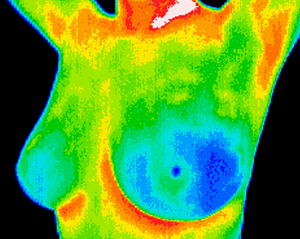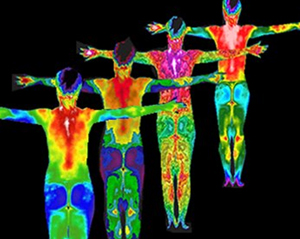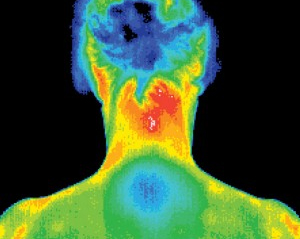What is Thermography?
Thermography is digital infrared imaging (DII). Using a highly sensitive, thermal imaging
camera, digital infrared imaging accurately measures heat from the surfaces of the breasts, detecting temperature differences. It is non-invasive, radiation-free and there is no compression. DII can detect benign tumors, simple cysts, fibrocysts, infections and other conditions.
Simply put, we all have our own unique, set patterns in our breasts, like a “thermal fingerprint”. These patterns should never change and will remain constant throughout our lives. Before a tumor begins to grow, it has to establish its own network of blood vessels, a new blood supply to feed it. This new network of vascularity changes your set patterns. A thermogram can detect these changes within two years of its onset.
The ideal early warning system would detect both the pre-cancerous changes occurring in the breast and the first cancer cell formations. Digital Infrared Imaging has the ability to detect the chemical and blood vessel changes in pre-cancerous as well as cancerous breast tissue. DII can be the first indicator that a cancer may be forming or present; and in many cases from 8-10 years before it can be detected by any other method.
Cancer cells used to be normal cells, but because of DNA or cell mutation, the cells have replicated out of control, becoming cancerous. When our immune systems are a strong immune system with lots of antioxidants from fruits and vegetables, especially the green leafy kind (broccoli, kale, brussels sprouts, cauliflower, spinach, etc.). Also, there are hundreds of studies and research to show that radiation affects and damages the very DNA in our cells, especially with repeated exposure.
There are other things that can cause cancer. Hormonal imbalances, environmental pollution, family history, the foods we eat, can all cause our immune systems to fail. Most breast cancers are estrogen dependent, which is why it is crucial for every woman to check their hormone levels. You can do this through your OB/GYN. It is not only important to see what your hormone levels are, but to see how they are metabolizing with a special blood test called Estronex. Since this is not a routine test, you must ask for it by name, or see a qualified nutritionist who can give you the test.
Three months after my mastectomy, I had a thermogram, and there were already new vascularities developing in my left breast. This is when I sought the help of a nutritionist With a simple blood test, I was told that my estrogen was metabolizing in such a way as to promote cancer growth. With a strict diet, the right supplements and balabcing my hormones, I was able to get it under control.
When was Thermography First Used to Investigate Breast Cancer?
TDigital Infrared Imaging was first used to investigate breast cancer in 1957 by Dr.
Raymond Lawson, M.D., a surgeon and tumor metabolism researcher. Since then, there
have been over 800 peer-reviewed studies in medical literature, studying over 300,000
women. In 1982, the FDA approved thermography as a breast screening procedure.
Over the past 30 years, there have been larger studies supporting its effectiveness, as
well as the development of strict, standardized protocols, and technological advancements
in imaging hardware and computer processing.
Mammography vs. Thermography
Researchers have long warned that the compressive force used to obtain useable mammo-
grams may be a contributing factor to breast cancer:
The British standard for the force used to squeeze the breast as flat as possible corresponds
to placing twenty 1 kilogram bags of sugar on each breast. Researchers [at the University
of Aberdeen, Scotland] fear that this force may be excessive and enough to dislocate and
spread any existing cancer cells. Animal experiments have shown that the number of cancer
sites can increase by as much as 80% when tumors are manipulated mechanically. A recent
study in Malmo, Sweden found that the death rate from breast cancer among women under
55 was 29% higher in a group which had been screened with mammography than in the
unscreened control group. [2]
There is mounting evidence that the x-rays from repeated mammograms induce cancer.
Dr. John W. Gofman, an authority on the health effects of ionizing radiation, estimates that
75 percent of breast cancer could be prevented by avoiding or minimizing exposure to the
ionizing radiation. This includes mammography, x-rays and other medical and dental sources.
"Since a mammogram is basically an x-ray (radiation) of the breast, I do not recommend
mammograms to my patients for two reasons: 1) Few radiologists are able to read
mammogams correctly, therefore limiting the procedure's effectiveness. Even the man who
developed this technique stated on national television that only about six radiologists in the
United States could read them correctly. 2) In addition, each time the breasts are exposed
to an x-ray, the risk of breast cancer increases by 2 percent."
The August 2007 issue of Radiology bemoans the growing number of mammography
centers across the United States that are closing down. Radiologists blame low
reimbursement from the insurance companies and a frightening degree of liability.
With mammograms, the false negative reading rates (not detecting cancers) range from
10% to 40%.
According to the 2002 Breast Cancer Study, issued by the Physician Insurers Association
of America (PIAA), internists were named in 7% of the surveyed failure-to-diagnose breast
cancer suits brought during the 1990s. Family physicians were named in 11% of cases and
gynecologists in 29%. Radiologists topped the list, however, being named in 40% of all
failure-to-diagnose breast cancer claims.
Studies of Thermography
Claudia Barrington Makes A Difference
Florida Thermography was founded by Claudia Barrington, RN in 2000 to offer women a safe, painless, reliable and risk-free breast screening option.
Claudia has helped thousands of women who have chosen Thermal Imaging for their annual breast-screening exam because it is quick, convenient, comfortable and effective. She has become the go to person for women who want and need a better, more trusted way to achieve their health prevention goals. Because the state-of-the-art equipment she uses is portable, Claudia is able and willing to go to her clients by visiting clinics and doctors offices throughout South Florida. It’s the most convenient way for you to get the exceptional service she provides.
In addition to Infrared Imaging, Claudia provides both individual and group education on women’s health and breast cancer prevention. She speaks to women who want control, confidence and peace of mind.
Susan G. Komen Study
The Susan G. Komen Foundation funded a study released in May, 2007, that essentially
found that our increasingly polluted and toxic environment is much to blame for the rise in cancer. As reported in the press: [11] More than 200 chemicals – many found in urban air and everyday consumer products – cause breast cancer in animal tests, according to a compilation of scientific reports published today.
Writing in a publication of the American Cancer Society, researchers concluded that reducing exposure to the compounds could prevent many woman from developing the disease.
The research team from five institutions analyzed a growing body of evidence linking environmental contaminants to breast cancer, the leading killer of U.S. woman in their late 30s to early 50s.
Experts say that family history and genes are responsible for a small percentage of breast cancer cases but that environmental or lifestyle factors such as diet are probably involved in the vast majority. In other words, environmental toxins continually pollute the body. Our natural detoxification systems work less efficiently over time. More free radicals are formed, damaging our DNA. The stage is set for disease. Thermography is a screening \ damaging our DNA. The stage is set for disease. Thermography is a screening tool which can help raise suspicions of breast cancer at an early stage, when there is still chance of complete cure.
Fast Facts
Florida Thermography was founded by Claudia Barrington, RN in 2000 to offer women a safe, painless, reliable and risk-free breast screening option.
In 1982, the FDA approved breast thermography as an adjunct diagnostic breast cancer screening procedure
Of the extensive research conducted since the late 1950's, well over 300,000 women have been included as study participants
The size of the studies are very large: 10k, 37k, 60k, 85k
Some studies have followed participants up to 12 years
Strict standardized interpretation protocols have been established for 15 years to remedy problems with early research.
Breast thermography has an average sensitivity and specificity of 95%
An abnormal thermogram is 10 times more significant as a future risk indicator for breast cancer than a first order family history
A persistent abnormal thermogram carries with it a 22x higher risk of future breast cancer
Extensive clinical trials have shown that breast thermography significantly augments the long term survival rates of its recipients by as much as 61%. When used as a multimodal approach (clinical exam +mammography+thermography), 95% of early stage cancers will be detected.
Instructions Before Your Appointment
1. No vigorous exercise 2 hours before your appointment time.
2. No excessively hot baths or showers 2 hours before.
3. No lotions, oils or creams from the waist up.
4. Do not apply deodorant.
5. No sunbathing that day.
6. If you smoke, do not smoke 2 hours before your appointment time.
Better yet - quit!
Partial and Full-body scans also available. Call for Details.
Research Studies And Articles
Studies show that 15% of all breast cancers occur in women between the ages of 20 to 44 (1).
Mammography is difficult to interpret in the age group due to the density of the breast. Women who
are on hormone replacement therapy, nursing or have fibrocystic, large or augmented breasts can
cause reading difficulties (2,3). While there is no one screening test that is 100% accurate (1,3,4),
current research shows a 61% increase in survival rate when thermography is added to a woman’s
regular breast check-up. Thermography introduces a 90% accurate screening test for younger women
and provides the earliest breast cancer detection to date for women of all ages.
1. ACS Breast Cancer Guidelines and Statistics. 2005-2006
2. Belliveau N., M.D. et al. “Infrared imaging of the Breast: Initial Reappraisal Using High-
Resolution Digital Technology in 100 Successive Cases of Stage I and Stage II Breast Cancers."
Breast Journal 4.4 (1998).
3. Gamigami P., M.D. Atlas of Mammography; New Early Signs of Breast Cancer. Blackwell Science,
1996.
4. Gautherie M., Ph.D. “Thermobiological Assessment of Benign and Malignant Diseases.” American
Journal of Obstetrics and Gynecology 147.9 (1983); 861-869.
5. Nyirjesy, I. M.D. et al. “Clinical Evaluation Mammography and Thermography in the Diagnosis of
Breast Carcinomas.” Thermology 1 (1986) 170-173.
6. Beating Breast Cancer (Article)
7. Infrared Imaging of the Breast - An Overview (2006 - Chapter 25 of the Biomedical
Engineering Handbook, Third Edition, Medical Devices and Systems)
8. Nondestructive Testing of the Human Breast: The Validity of Dynamic Stress Testing
in Medical Infrared Breast Imaging (IEEE - Engineering in Medicine and Biology Journal)
9. Infrared Imaging of the Breast: Initial Reappraisal Using High-Resolution Digital
Technology in 100 Successive Cases of Stage I and II Breast Cancer (The Breast Journal)
10. Efficacy of Computerized Infrared Imaging Analysis to Evaluate Mammographically
Suspicious Lesions (American Journal of Radiology)
11. Advances in Medical Infrared Imaging (IEEE - Engineering in Medicine and Biology
Journal)
12. Relationship Between Microvessel Density and Thermographic Hot Areas in Breast
Cancer (Surgery Today Journal)
13. Manipulation of the Primary Breast Tumor and the Incidence of Sentinel Node
Metastases From Invasive Breast Cancer (Archives of Surgery Journal)
14. Influence of Estrogen Plus Progestin on Breast Cancer and Mammography in
Healthy Postmenopausal Women (Journal of the American Medical Association -
The Women’s Health Initiative Randomized Trial)
15. Estrogens, Steroidal (Tenth Report on Carcinogens - National Institutes of Health)
16. Endogenous Estrogens as Carcinogens Through Metabolic Activation (Journal of the
National Cancer Institute)
17. Estrogens as Endogenous Genotoxic Agents—DNA Adducts and Mutations (Journal
of the National Cancer Institute)
18. Tissue-Specific Synthesis and Oxidative Metabolism of Estrogens (Journal of the
National Cancer Institute)
19. Endocrine Disrupters and Human Health: Could Oestrogenic Chemicals in Body
Cosmetics Adversely Affect Breast Cancer Incidence in Women?
20. Chemo Prevention of Cancer (Carcinogenesis Journal)
21. Vascular Targeting Agents as Cancer Therapeutics (Clinical Cancer Research Journal)
